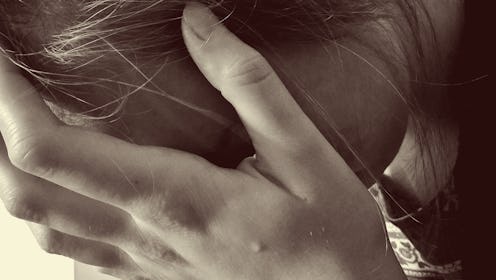Life
Here Are All The Scientific Reasons We Cry

At some point in your life, you’ve probably heard an ex-partner exclaim, mid-breakup, “Crying won’t change anything!” So, if that is actually the case, then why do we cry? I wasn’t always a big crier — in fact, I prided myself on my emotional aloofness. I thought crying was a useless tick. Sad scene in a movie? Didn't phase me! Break up with a boyfriend? I’m better off without him anyway! But over the years, something strange happened. I feel that as I’ve gotten older, as corny as it sounds, my heart expanded like the mean old Grinch, and I have become more open to experiencing my emotions.
My views haven’t changed drastically, and I don’t seek out sad material, but now, I cry at the drop of a hat. A touching TV commercial — tears are instantly trickling my cheeks. Boyfriend going on a trip for a few days — you’d think it was the end of the world. But whether you’re a big ol’ softy like me, or reserve your tears for more select occasions, the science behind why and how we cry is the same.
But when we talk about “crying,” it is important to note that we are probably referring to something different than “lacrimation.” Crying refers to the shedding of tears in response to emotion, and lacrimation is the secretion of tears, due to non-emotional reflex. The word “lacrimation” stems from "lacrima"— the Latin word for tears. And we can thank our eyes' “lacrimal system” for all the waterworks.
In fact, we produce three different kinds of tears in response to these different stimuli: basal, reflex, and psychic (or emotional). All of these tears have different and important jobs to do. Basal tears keep our eyes lubricated throughout the day. They are nutrient-rich and have antibacterial properties. Reflex tears protect and cleanse the eye of any irritants, like smoke, dust, or cutting an onion. Lastly, there are psychic tears. These can be cued by a whole slew of emotions — sadness, happiness, anger, stress. You also experience strong emotions when you get physically hurt, and these are the tears you emit. Humans are the only species known to produce these kinds of tears — no matter what cartoons would have you believe.
So how does our body know when to turn on and off the faucet? Our lacrimal system gets the message through an advanced lightning-fast game of telephone. The limbic system, which is the part of your brain that processes emotion, is wired to your automatic nervous system. Strong emotions cues your nervous system to tell your lacrimal system to start pumping out those tears! The lacrimal system can produce and drain tears at the same time. You produce a tear from the gland located between your lid and eyeball. Once you blink reflexively, the tear is spread across your eye and drains into a duct which flows into the nose. Which is why we look so gorgeous with all that snot smeared elegantly across our face.
But why cue the tears in the first place? Well, these emotional tears come equipped with a secret weapon. They contain leucine enkephalin — a natural painkiller. They also release a surplus of stress hormones like cortisol and prolactin, so this hormonal release is partly to thank for the sense of calm you have after a good cry. Many believe that this emotional crying helps keep our depression, anger, and stress in check, by ridding us of some of these hormones in the tears. So don't hold back next time you feel like shedding a few!
From a psychological and evolutionary standpoint, there are many theories as to why we cry. Crying isn't merely a physiological response, but may strengthen relationship bonds as well. When a person cries it elicits help from those around them in a non-verbal way. Genuine tears can bond people together and for a community (just like politicians from Bill Clinton to Obama have successfully shown). Further analysis shows that crying is an important evolutionary mechanism for showing submission. Dr. Oren Hasson, an evolutionary psychologist at Tel Aviv University, explains, "My analysis suggests that by blurring vision, tears lower defenses and reliably function as signals of submission, a cry for help, and even in a mutual display of attachment and as a group display of cohesion." With all these health and psychological benefits we should never be afraid to let it all out. Seems like big girls and boys do cry!